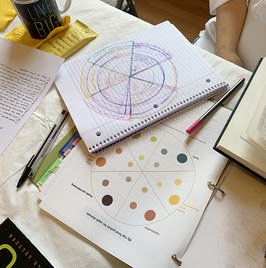A 5-Day Journey to Authentic Living
/If you have had the exciting experience of seeing something unfold in real time that you have believed, spoken or written about, and maybe have taught, then you will relate to my experience last week.
You may be familiar with my story, and how I had been a graphic designer who was completely blocked when it came to creating for myself. Creating (as I used to believe) meant things like painting or making art with pastels. I was terrified to even try. I stayed focused on solving clients’ problems and telling their stories.
The trajectory of my journey changed when I started working with a great coach. I woke up to the fact that I was ready for a significant change and sold my design firm. And I courageously started exploring creative expression.
I then met a great teacher who was an expert on the vast power of creativity, and studied with him for two years. I came to understand the mysteries of creativity and appreciate the breadth of what it is. I also vastly expanded the ways that I created.
My life was transformed.
Lives change when creative power is ignited
I developed my Creative Core Coaching practice to help other accomplished women who yearned to live a more fulfilling, rich authentic life.
They are typically so busy that they are disconnected from their hearts.
They are often frazzled, some to the point of burnout.
Many are living a smaller version of who they know they can be.
Many struggle to find clarity about what is next — or could be next.
Many want to rebuild confidence.
They are sacrificing themselves in ways that I had lived for far too long.
When they are supported to tap their creative power and ignite it, they thrive!
And, change can be accellerated
In 2020, I created the first of what are three retreat experiences I offer each year.
At each, small groups of women come together to take a deep dive into self-discovery, have creative experiences that open their hearts, and set a course for meaningful change.
When you step away from your routine and are willing to immerse yourself in new experiences that bring incredible insights to life, you find true inspiration for new ways of living.
Creation Vacation 2025 was magical
Last week, the Creation Vacation retreat kicked off a big new year for a fantastic group of women.
We spent 5 days in a glorious house on the southern coast of Maine. We did powerful work together. And we had tremendous fun!
The mix of deep thoughtful exploration and lots of fun with expressive creative play that built energy and opened hearts, made for a huge experience for everyone.
We ate beautifully. We shared deeply. A remarkable practitioner helped us all expand energetically and somatically anchor in supportive energy. The setting of extraordinary natural beauty was the perfect environment for all of it to unfold.
I am savoring the joy of leading the retreat and witnessing so much exciting evolution.
Take a look at the photos below, and consider if your creative spirit feels the desire to expand!
If you feel the urge to be supported to ignite the creative power that is within you now, and set a course for a bigger, more fulfilling life, let’s connect and talk.
Schedule a call today.


























































